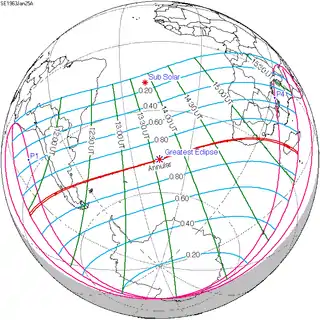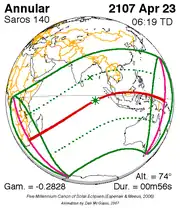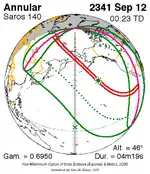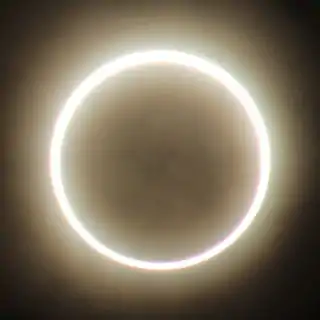Solar eclipse of December 23, 1908
A hybrid solar eclipse occurred on December 23, 1908. A solar eclipse occurs when the Moon passes between Earth and the Sun, thereby totally or partly obscuring the image of the Sun for a viewer on Earth. A total solar eclipse occurs when the Moon's apparent diameter is larger than the Sun's, blocking all direct sunlight, turning day into darkness. Totality occurs in a narrow path across Earth's surface, with the partial solar eclipse visible over a surrounding region thousands of kilometres wide. This event is a hybrid, starting and ending as an annular eclipse. Annularity was visible from Chile, Argentina, Uruguay and southern Brazil, while totality was visible only from southern Atlantic Ocean with no land.
| Solar eclipse of December 23, 1908 | |
|---|---|
 Map | |
| Type of eclipse | |
| Nature | Hybrid |
| Gamma | −0.4985 |
| Magnitude | 1.0024 |
| Maximum eclipse | |
| Duration | 12 sec (0 m 12 s) |
| Coordinates | 53.4°S 0.5°W |
| Max. width of band | 10 km (6.2 mi) |
| Times (UTC) | |
| Greatest eclipse | 11:44:28 |
| References | |
| Saros | 140 (23 of 71) |
| Catalog # (SE5000) | 9301 |
Related eclipses
Solar eclipses 1906–1909
This eclipse is a member of a semester series. An eclipse in a semester series of solar eclipses repeats approximately every 177 days and 4 hours (a semester) at alternating nodes of the Moon's orbit.[1]
| Solar eclipse series sets from 1906–1909 | ||||
|---|---|---|---|---|
| Ascending node | Descending node | |||
| 115 | July 21, 1906 Partial |
120 | January 14, 1907 Total | |
| 125 | July 10, 1907 Annular |
130 | January 3, 1908 Total | |
| 135 | June 28, 1908 Annular |
140 | December 23, 1908 Hybrid | |
| 145 | June 17, 1909 Hybrid |
150 | December 12, 1909 Partial | |
Saros 140
It is a part of Saros cycle 140, repeating every 18 years, 11 days, containing 71 events. The series started with partial solar eclipse on April 16, 1512. It contains total eclipses from July 21, 1656, through November 9, 1836, hybrid eclipses from November 20, 1854, through December 23, 1908, and annular eclipses from January 3, 1927, through December 7, 2485. The series ends at member 71 as a partial eclipse on June 1, 2774. The longest duration of totality was 4 minutes, 10 seconds on August 12, 1692.
| Series members 23–53 occur between 1901 and 2450: | ||
|---|---|---|
| 23 | 24 | 25 |
 Dec 23, 1908 |
 Jan 3, 1927 |
 Jan 14, 1945 |
| 26 | 27 | 28 |
 Jan 25, 1963 |
 Feb 4, 1981 |
 Feb 16, 1999 |
| 29 | 30 | 31 |
 Feb 26, 2017 |
 Mar 9, 2035 |
 Mar 20, 2053 |
| 32 | 33 | 34 |
 Mar 31, 2071 |
 Apr 10, 2089 |
 Apr 23, 2107 |
| 35 | 36 | 37 |
 May 3, 2125 |
 May 14, 2143 |
 May 25, 2161 |
| 38 | 39 | 40 |
 Jun 5, 2179 |
 Jun 15, 2197 |
 Jun 28, 2215 |
| 41 | 42 | 43 |
 Jul 8, 2233 |
 Jul 19, 2251 |
 Jul 29, 2269 |
| 44 | 45 | 46 |
 Aug 10, 2287 |
 Aug 21, 2305 |
 Sep 1, 2323 |
| 47 | 48 | 49 |
 Sep 12, 2341 |
 Sep 23, 2359 |
 Oct 3, 2377 |
| 50 | 51 | 52 |
 Oct 14, 2395 |
 Oct 25, 2413 |
 Nov 5, 2431 |
| 53 | ||
 Nov 15, 2449 | ||
References
- van Gent, R.H. "Solar- and Lunar-Eclipse Predictions from Antiquity to the Present". A Catalogue of Eclipse Cycles. Utrecht University. Retrieved 6 October 2018.
- Earth visibility chart and eclipse statistics Eclipse Predictions by Fred Espenak, NASA/GSFC
.jpg.webp)

